Choc King Behavior: Interview with Celebrated Pastry Chef Pierre Hermé
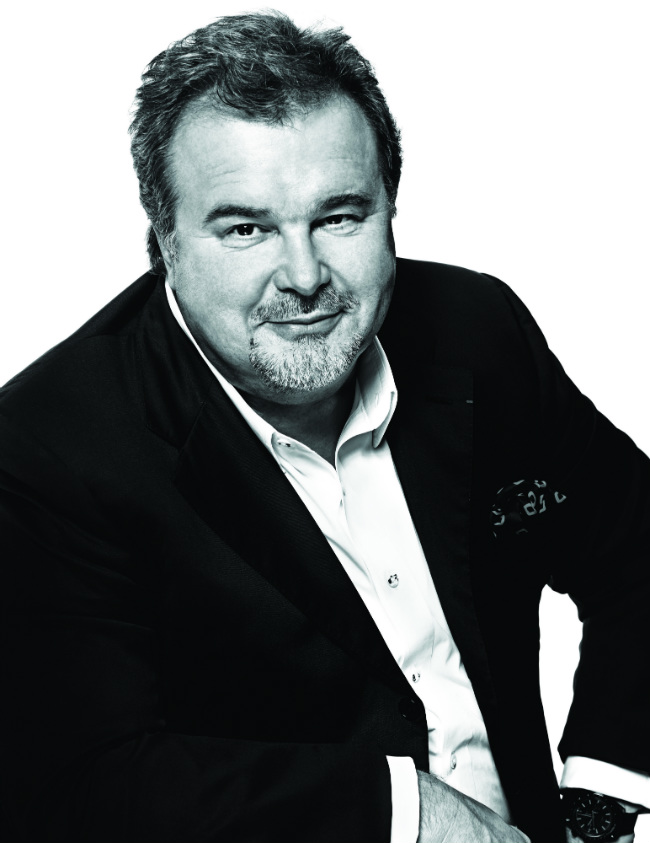
Insatiably creative, Pierre Hermé returns to his first passion in his new book. Retracing his longstanding love affair with the cacao bean, the book reveals creations that display the celebrated pastry chef ’s signature chocolate recipes and innovative style, which have transformed the realm of pâtisserie.
France Today: What is your earliest food memory, and your favourite dishes from childhood?
Pierre Hermé: I am not sure if it is my first memory, but my real madeleine de Proust has to be the Tarte aux Quetsches of my father. Just pastry, plums from Alsace and cinnamon sugar – a real delight that takes me back!
FT: How has being a child of north-eastern France influenced who you are, firstly as a Frenchman, and secondly as a baker?
PH: I grew up in Alsace – I am heir to four generations of Alsatian bakery and pastry-making tradition. There is a rich patrimony of gastronomy in the region and wonderful ingredients, but I wouldn’t say that is has influenced me in either aspect. My influences come mainly from my mentor, Gaston Lenôtre – I moved to Paris at the age of 14 to become an apprentice at his side.
FT: Tell us the inspiration behind your new book about chocolate.
PH: The latest book, Chocolate, is in collaboration with Sergio Coimbra, a Brazilian photographer – it is an entirely different way to look at chocolate. It is a book of art with over 200 stunning photos presenting chocolate and all its facets. I first starting working with Sergio on a calendar, 365 ways to love chocolate – he is an extraordinary talent, he travels the world researching taste and beauty and under his gaze, every ingredient, every dish seems to come alive! After the calendar, I didn’t want to stop – we came up with the idea of the book and I am very pleased with the result. It is totally different from any of the other books I have created and tells my story and relationship with chocolate in a new way.
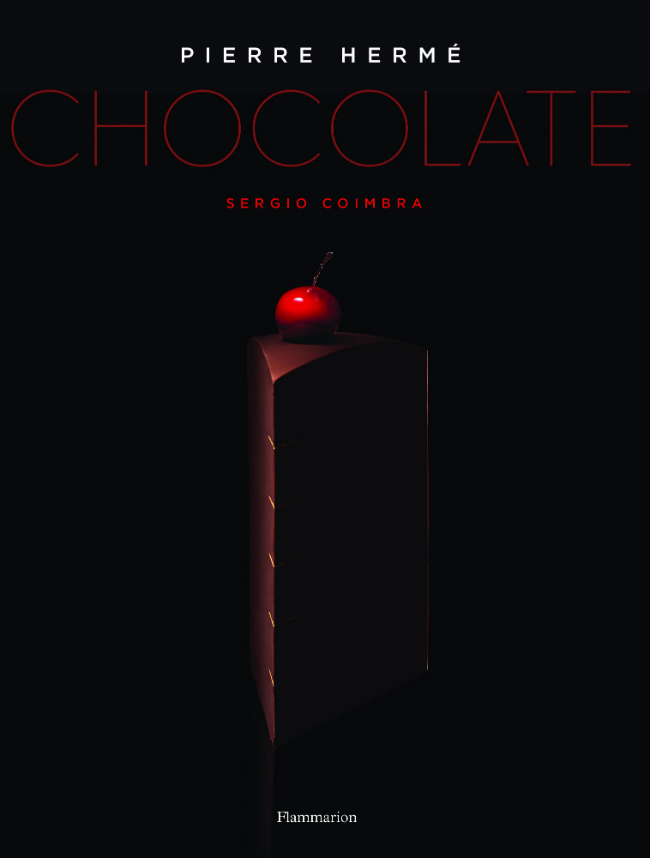
Chocolate by Pierre Hermé © 2016 Flammarion. Photography by Sergio Coimbra.
FT: Did you ever want to be anything other than a pâtissier?
PH: I knew from the age of nine that I wanted to be a pâtissier so I have never really thought about it… Perhaps an architect or a gardener. I have always been fascinated by architecture – in a way, I guess I am an architect of tastes!
FT: You’ve said that you use sugar as a seasoning like salt, to bring out other flavours…
PH: Yes, the role of sugar in pâtisserie has changed a lot over the years. For me, I use it where needs be – for technique or for taste.
FT: I’m coming round to yours for goûter (thanks for the invite!). What sweet treats would you create for me?
PH: Macarons would be on the table – why not the latest creations of the Les Adorables collection – our Christmas macaron collection? The macaron Infiniment Citron Noir made with black lemon from Persia – it is lemon that is boiled and dried – this lowers the acidity. It’s a very interesting product used often in Iranian cuisine. I transformed it for this macaron. It is a wonderful flavour.
FT: Your creations are famously unfancy. What do you have against over-elaborate presentation?
PH: It is just not my style – I prefer to concentrate on the ingredients, on the taste. I tend to add decorative elements only where it adds something to the taste experience. For me, in the appearance of a dessert or a pastry, the technique behind it should be invisible.

From Chocolate by Pierre Hermé © 2016 Flammarion. Photography by Sergio Coimbra.
FT: You recently won the title of Best Pastry Chef in the world – congratulations! What further ambitions do you have?
PH: Thank you! This title is a great honour and a pleasure. For me, not only is it great recognition for French savoir-faire in pastry on an international level but it is a great honour to all pastry chefs, starting with my teams, the pastry chefs working at the Maison Pierre Hermé Paris, preparing my recipes every day, around the world. The most important thing – it drives me to continue, to keep creating, keep surprising and innovating. We have a number of projects for the Maison Pierre Hermé Paris, whether it is here in London, in Paris or around the world – the aim is to keep creating new taste experiences!
FT: What is the single most important piece of advice you can give an amateur or home pastry chef?
PH: For a home pastry chef – always follow the recipe! To the letter and with no substitutes. Pâtisserie is not like cooking, there is no room for improvisation. It is scientific – it doesn’t have to be complicated, but demands a lot of precision and attention to detail!
For amateur pastry chefs – work with passion and take the time to learn. Pâtisserie is not just about mastering technique and recipes, but about understanding the environment, taking interest in the ingredients, their origins and being truly curious.
FT: As someone who grew up in Colmar, can you tell us about what makes the region’s Christmas markets so special?
PH: Christmas markets are traditionally Germanic, the region of Alsace is openly subjected to this influence. A Christmas market is a mix of specific Christmas products and regional specialities. In Alsace, at a Christmas market you will always have vin chaud, as well as bredele – small traditional Alsatian biscuits – stollen, beerawecka – a traditional fruit bread – as well as Alsatian keepsakes, savoury specialities, Alsatian wines… For me, what characterises a Christmas market is the smell of vin chaud!
FT: And finally, you are granted three wishes to change gastronomic life – the nation’s food habits – in France. What would they be?
PH: I would ensure that all superfluous decor is removed from the plate, I would banish the smoking of all products – except for charcuterie and salmon! And I would banish the tonka bean! (Joke!)
Recipes excerpted from Chocolate by Pierre Hermé © 2016 Flammarion. Photography by Sergio Coimbra. Recipe text and artistic direction by Coco Jobard. editions.flammarion.com
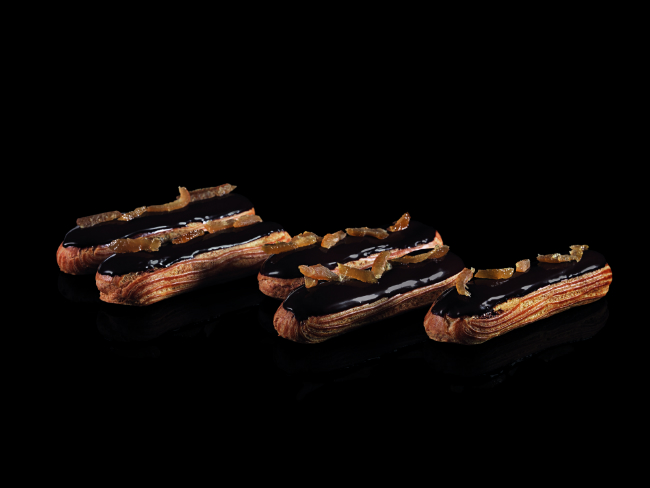
From Chocolate by Pierre Hermé ©
2016 Flammarion. Photography by Sergio Coimbra.
Azur Éclair
Makes about 20 eclairs | Preparation Time: About 1 h | Cooking Time: About 25 mins | Chilling Time: 30 mins
Ingredients
Choux Pastry:
7 tablespoons + 2 teaspoons (3 3/4 oz./110 g) butter
1/2 cup (4 1/3 oz./125 g) mineral water
1/2 cup (4 1/3 oz./125 g) whole milk
1 teaspoon (5 g) superfine sugar
1 teaspoon (5 g) Fleur de sel, preferably Guérande
1 1/2 cups (5 oz./140 g) flour
1 cup (8 3/4 oz./250 g) whole eggs
Manjari Chocolate and Yuzu Cream:
2 teaspoons (1/3 oz./8 g) powdered gelatin, or 4 gelatin sheets of 2 g
13 1/4 oz. (375 g) Manjari 64% dark chocolate (Valrhona)
1 cup (8 oz./225 g) yuzu juice
1 cup (8 oz./225 g) egg yolks
1 cup (8 oz./225 g) superfine sugar
2/3 cup (5 3/4 oz./165 g) whole milk
2 cups (16 1/3 oz./465 g) liquid cream
Chocolate Glaze:
1/3 cup (3 oz./90 g) mineral water
1/2 cup (3 1/2 oz./100 g) superfine sugar
2 3/4 oz. (80 g) cocoa paste, or 100% cocoa dark chocolate
17 2/3 oz. (500 g) fondant
Finishing:
80 small pieces candied yuzu rind
Preparation
Prepare the choux pastry:
Cut the butter into pieces. Combine the water, milk, sugar, Fleur de sel and butter in a saucepan, and bring to a boil. Add the flour all at once, stirring briskly for two or three minutes, until the mixture is smooth and pulls away from the sides of the pan. Turn the mixture into a bowl and add the eggs, little by little, stirring briskly to incorporate the eggs well after each addition. Preheat the oven on convection setting to 395°F (200°C/Gas Mark 6-7). Spoon the mixture into a pastry bag fitted with a BF18 star pastry tip. Line a pastry sheet with cooking parchment and pipe the dough out into even tube shapes, about 6 in. (15 cm) long, leaving space between each. Place in the preheated oven and turn off the heat immediately. After ten minutes, turn the oven back on to 340°F (170°C/Gas Mark 5-6) and cook for an additional ten minutes. After ten minutes, open the oven door very slightly (slide a spoon into the door to keep it ajar if necessary) and cook for an additional ten minutes. Remove from the oven and transfer the éclairs to a pastry rack to cool.
Prepare the Manjari chocolate and yuzu cream:
1. Sprinkle the powdered gelatin into a little warm water to soften. (If using sheet gelatin, place in a bowl of cold water for fifteen minutes to soften, then squeeze between the palms of your hands to drain.) Chop the chocolate with a serrated knife and place it in a bowl. Heat the yuzu juice in a saucepan to 120°F (50°C).
2. Whisk the egg yolks and sugar together in a bowl. Bring the milk and cream to a boil in a saucepan and pour, whisking constantly, over the egg yolk-sugar mixture. Add the warm yuzu juice. Pour the mixture back into the saucepan and cook, whisking constantly, to 185°F (85°C). Stir in the gelatin. Pour the mixture over the chopped chocolate, stirring. Mix with a hand blender. Press a sheet of plastic film directly on the surface of the mixture and refrigerate until cooled.
3. With the point of a No. 6 plain pastry tip, pierce three holes spaced evenly along the bottom side of each éclair. Fill the pastry bag with the chocolate-yuzu cream, and pipe the cream evenly and generously into the three holes on the bottom of each éclair. Refrigerate.
Prepare the chocolate glaze:
1. Combine the water and sugar in a saucepan, and bring to a boil to make a sugar syrup. Remove from the heat and let cool. Chop the cocoa paste with a serrated knife and melt in a bowl over a bain-marie of simmering water. Knead the fondant between the palms of your hands until softened.
2. In a shallow bowl, combine the fondant with a few tablespoons of sugar syrup and the melted cocoa paste.
3. Add enough additional sugar syrup to obtain a supple, fluid texture.
4. Place the glaze in a wide shallow bowl. Glaze the éclairs, one at a time, holding each upside down over the glaze, and dipping the top quickly in the chocolate. Remove, turn the éclair right side up and run your index finger around the glaze to make a neat edge, removing any glaze that may have dripped down. Decorate the top of each éclair with four pieces of candied yuzu rind and refrigerate for thirty minutes before serving.
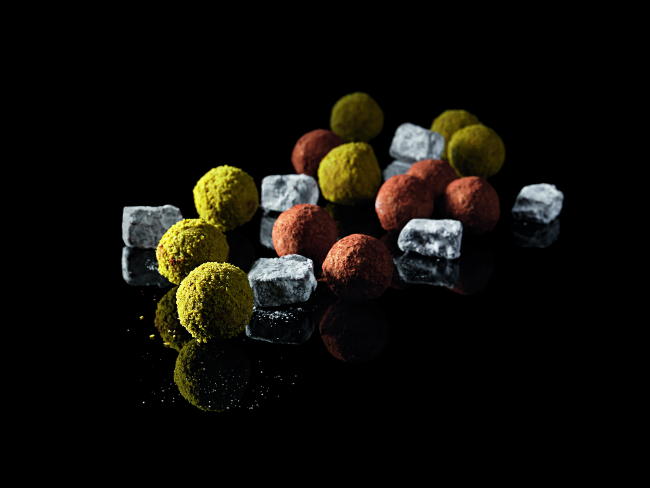
From Chocolate by Pierre Hermé © 2016 Flammarion. Photography by Sergio Coimbra.
Milk Chocolate and Matcha Green Tea Truffles
Makes about 70 truffles | Finishing: Pistachio powder | Preparation Time: 45 mins | Cooking Time: About 18 mins
Ingredients
Roasted Pistachios:
7 oz. (200 g) whole pistachios, skinned
Milk Chocolate and Matcha Green Tea Ganache:
6 1/2 tablespoons (3 1/3 oz./95 g) butter
21 1/2 oz. (610 g) milk chocolate, 45% cocoa
4 3/4 tablespoons (1 oz./30 g) matcha green tea powder
2 1/2 cups (21 oz./600 g) liquid cream
Preparation:
Prepare the roasted pistachios:
Preheat the oven to 340F (170C/Gas Mark 5-6). Spread the pistachios out on a baking sheet lined with cooking parchment. Place it in the preheated oven to toast the pistachios for about fifteen minutes, stirring and turning every five minutes. Remove and set aside to cool.
Prepare the milk chocolate and matcha green tea ganache:
1. Cut the butter into pieces. Chop the chocolate with a serrated knife and place in a bowl with the matcha green tea powder. Bring the cream to a boil. Pour it, one third at a time, over the chocolate and matcha tea powder, stirring from the center out in small, then progressively larger concentric circles. Once the temperature of the chocolate has reached 95F-105F (35C-40C), incorporate, little by little, the pieces of butter, whisking until the ganache is smooth. Line the bottom and sides of a small baking dish with plastic film. Pour the ganache into the dish in a layer of about 1/3 in. (1 cm) thick. Cover with plastic film, pressing the film directly onto the surface of the chocolate. Refrigerate until the ganache is set.
2. Sprinkle the pistachio powder in a bowl. Remove the plastic film from the ganache and turn it out onto a cutting board. Cut into cubes of 1/3 in. (1 cm). Press a roasted pistachio into the center of each cube, then roll into a ball between the palms of your hands. Place the balls, one by one, in the bowl with the pistachio powder and roll to coat with the powder. Place the truffles in a sifter to remove any excess pistachio powder. Store in an airtight container.
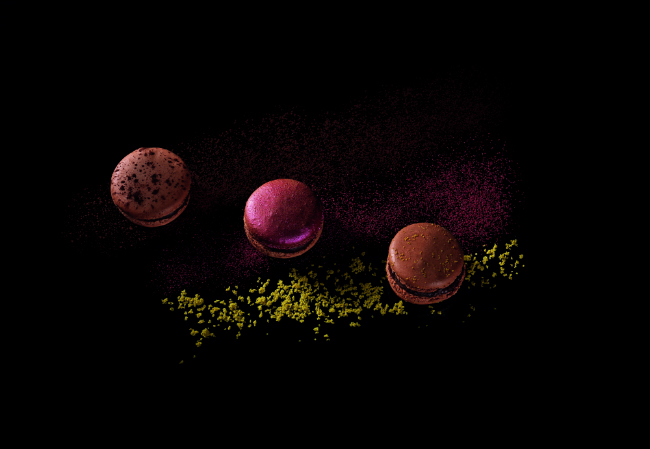
From Chocolate by Pierre Hermé © 2016 Flammarion. Photography by Sergio Coimbra.
Infiniment Chocolat Macaron
Makes about 72 macarons (or about 144 shells) | Preparation Time: 2 mins (5 days in advance); 1 hour (the same day) | Cooking Time: About 25 mins | Resting Time: 30 mins | Chilling Time: 2 h + 24 h
Ingredients
Macaron Shell:
1 cup (7 2/3 oz./220 g) (or about 8) “liquefied” egg whites, divided. See note.
3 1/2 cups (10 1/2 oz./300 g) ground almonds
2 cups + 5 tablespoons (10 1/2 oz./300 g) confectioners’ sugar
4 1/4 oz. (120 g) pure cocoa paste or dark chocolate, 100% cocoa
3/4 teaspoon (4.5 g) carmine red food colouring
1 1/2 cups (10 1/2 oz./300 g) superfine sugar
1/3 cup (2 2/3 oz./75 g) mineral water
Cocoa powder
Infiniment Chocolat Ganache:
2/3 cup (5 oz./140 g) butter at room temperature
12 3/4 oz. (360 g) Guanaja 70% dark chocolate (Valrhona)
1 1/3 oz. (40 g) pure cocoa paste (or dark chocolate 100% cocoa)
1 2/3 cups (14 oz./400 g) liquid cream
Finishing:
Cocoa powder
Preparation:
1. Five days in advance, place the egg whites for the macaron shells in a bowl, cover tightly with plastic film, pierce a few holes in the film and refrigerate to liquefy. One day in advance, prepare the macaron shells: sift the ground almonds and the confectioners’ sugar together in a bowl. Chop the cocoa paste and place in a bowl over a bain-marie of simmering water to melt to 122F (50C). Combine 1/2 cup (110 g) of liquefied egg whites with the food colouring. Pour onto the sifted almond powder-sugar mixture without mixing.
2. Combine the sugar and water in a saucepan and bring to a boil, monitoring the temperature with a thermometer. Meanwhile place the remaining 1/2 cup (110 g) of liquefied egg whites in the bowl of a mixer fitted with a wire whisk. Once the sugar syrup has reached 239F (115C), begin beating the egg whites on high speed.
3. Once the syrup has reached 244F (118C), reduce the mixer speed to medium and begin pouring the syrup in a steady stream into the beaten egg whites. Continue beating until the mixture cools to 122F (50C). Using a spatula, fold the meringue mixture into the almond-sugaregg white mixture. Add the melted cocoa paste, mixing until the batter loses a little volume. Spoon the batter into a pastry bag fitted with a No. 11 plain tip (1/2 in. diameter). Line baking sheets with cooking parchment and pipe out rounds of batter about 1 1/2 in. (3.5 cm) in diameter, spaced about 3/4 in. apart. Tap the baking sheets gently on a work surface covered with a kitchen towel to smooth the surface. Place the cocoa powder in a sifter and sprinkle lightly over the macaron shells. Set aside at room temperature for at least thirty minutes to allow a “skin” to form. Preheat the oven on convection setting to 355F (180C/Gas Mark 6). Place the baking sheets in the oven and bake for twelve minutes, opening and closing the oven door quickly twice during the baking to release steam. Remove from the oven and slide the macaron shells onto the work surface.
4. Prepare the Infiniment Chocolat ganache:
Cut the butter into pieces. Chop the chocolate and cocoa paste with a serrated knife, and place them in a bowl. Bring the cream to a boil in a saucepan and pour it, one-third at a time, over the chocolate and cocoa paste, stirring from the center out in small, then progressively larger concentric circles. When the temperature of the chocolate cools to 95F-104F (35C-40C), incorporate, little by little, the butter. Whisk until the ganache is smooth. Pour into a shallow dish. Press a sheet of plastic film directly onto the surface of the chocolate cream and refrigerate until the texture is creamy. Spoon the ganache into a pastry bag fitted with a No. 11 plain pastry tip. Turn half of the macaron shells over, flat side up, on the work surface and pipe the ganache generously onto each shell. Cover each with a second macaron shell. Refrigerate for twenty-four hours. The following day, remove the macarons from the refrigerator two hours before serving.
Note: “Liquefied” egg whites are egg whites that have been allowed to rest for several days to lose their elasticity. Simply place the egg whites in a bowl, cover with plastic film, pierce a few holes in the film and refrigerate for five to seven days.
As seen in France Today magazine
Share to: Facebook Twitter LinkedIn Email
Leave a reply
Your email address will not be published. Required fields are marked *




REPLY